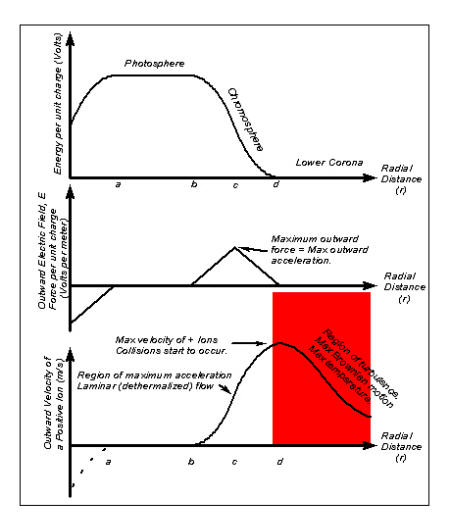|

Positive ions being accelerated by the double
layer of electrical charge
in the Electric Sunís chromosphere.
Top: Electrical energy of a positive ion as a
function of its position.
Middle: Outward force on a positive ion as a
function of its position.
Bottom: Outward velocity of a positive ion as a
function of its position.
Why the Lower Corona of the Sun
Is Hotter Than the Photosphere
Nov
16, 2010
The chaos of Brownian motion
produces the high temperature we see
in the solar corona.Of
all the ideas offered up as being an
explanation of the extreme
temperature (more than 2 million
Kelvin) measured in the lower corona
of our Sun, the simplest is that
electrically accelerated high
velocity positive ions are colliding
with relatively static ions and
neutral atoms in that location.
The electrical properties of the
Photosphere/Chromosphere/Lower
corona region of the Sunís visible
boundary is dominated by a double
layer (DL) of electrical charge.
This double charge layer is shown in
the bottom plot in the main figure
of the May 11, 2010, Picture of the
Day. The top and middle plots in
that figure are reproduced in the
image above.
Positive ions in the photospheric
plasma do not experience external
electrostatic forces when they are
within the photosphere (region a to
b in the figures). Only diffusion
motion (response to a concentration
gradient) and random thermal
(Brownian) movement occurs.
Temperature is simply the
measurement of the violence of those
random movements. The photosphere is
where the Sunís low ~5800 K surface
temperature is measured.
The top electrical energy
(voltage) plot shows that positive
ions have their maximum electrical
potential energy when they are in
the photospheric plasma. However,
their mechanical (kinetic) energy
(temperature) is relatively low. At
a point just to the left of the
right hand edge of the photospheric
energy plateau (point b), any random
movement toward the right (radially
outward) that carries a +ion even
slightly over the edge will result
in its being swept away, down the
energy hill, toward the right.
The middle plot in the figure
above shows the strength of the
E-field (voltage gradient)
consistent with this spatial voltage
distribution. This electric field is
the force per unit positive charge
applied to any +ions in this region.
In region b to d this force
accelerates each such +ion in the
outward direction. The acceleration
produced by this E-field is a
maximum at point c, and the +ionsí
outward velocities reach a maximum
value somewhere near point d.
As these positive ions accelerate
down the steep potential energy
drop, they exchange the high
(electrical) potential energy they
had in the photosphere into kinetic
energy Ė they gain extremely high
outward radial velocity and lose
side-to-side random motion. Thus
they become "de-thermalized." This
is because in this region of high
radial acceleration, the movement of
these ions becomes extremely
organized (parallel). Their
temperature, which is just a measure
of their random motion, drops to a
minimum.
When these rapidly traveling
+ions pass beyond the reach of the
intense outwardly directed E-field
force that has been accelerating
them, they have reached the bottom
of the hill and are moving much
faster than when they were at the
top. Because of their high kinetic
energy, any collisions they have at
this point with other ions or
neutral atoms are violent. This
creates high-amplitude random
motions, thereby "re-thermalizing"
all ions and atoms in this region
(shown in red) to a much higher
temperature. The sparkling x-ray
emissions that have been observed
here in the lower corona are
undoubtedly due to these collisions.
Ions just above (in the diagram,
to the right of) point d are
reported to be at temperatures of
one to two million K. Nothing else
but exactly this kind of result
could be expected from the Electric
Sun model.
The re-thermalization takes place
in a region analogous to the
turbulent white water that boils up
at the bottom of a smooth laminar
water slide. In the fusion model no
such (water slide) phenomenon exists
Ė and therefore neither does any
simple explanation of the observed
temperature discontinuity.
Notice that no mention has been
made in this process of magnetic
reconnection or, in fact, of any
magnetic mechanism whatsoever.
Strictly electric forces that occur
within the double charge layer above
the Sunís surface cause the observed
phenomenon.
Therefore it is clear that the
Electric Sun model straightforwardly
predicts the existence of the
observed temperature profile and
demonstrates how it occurs. If there
were no temperature discontinuity,
this would pose a problem for the
Electric Sun hypothesis.
Donald Scott author of
The Electric Sky
The author earned his Bachelor
and Master degrees in Electrical
Engineering at the University of
Connecticut in Storrs, Connecticut.
Following graduation he worked for
General Electric in Schenectady, New
York, and Pittsfield,
Massachusetts. He earned a Doctorate
in Electrical Engineering at the
Worcester Polytechnic Institute,
Worcester, Massachusetts, and was a
member of the faculty of the
Department of Electrical & Computer
Engineering at the University of
Massachusetts/Amherst from 1959
until his retirement in 1998.
|







